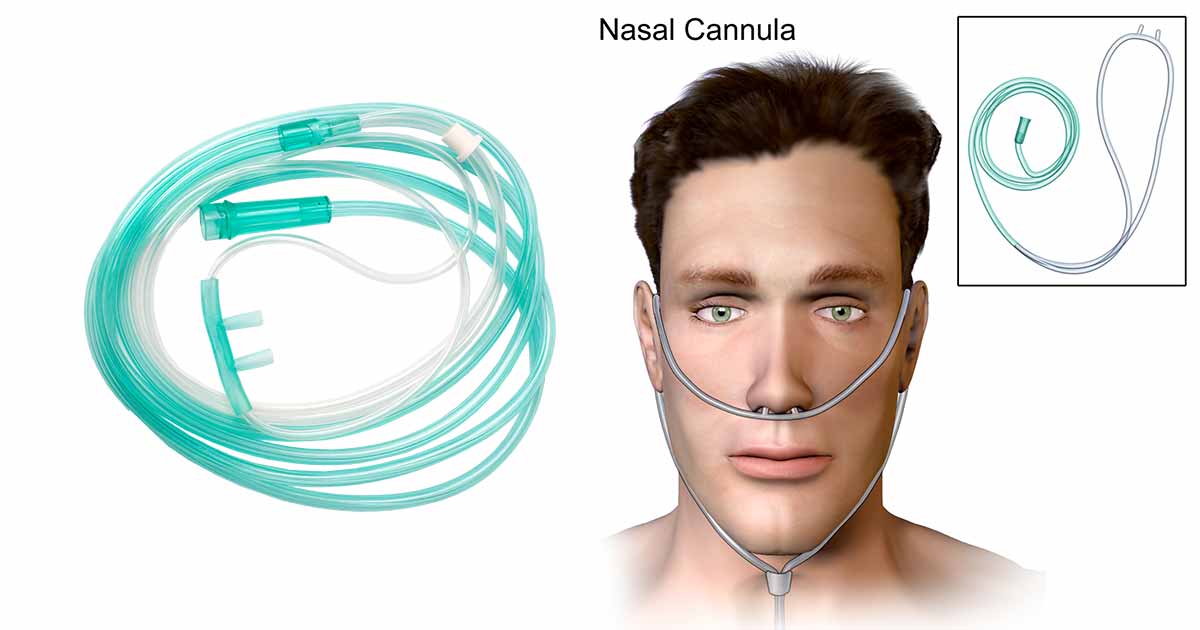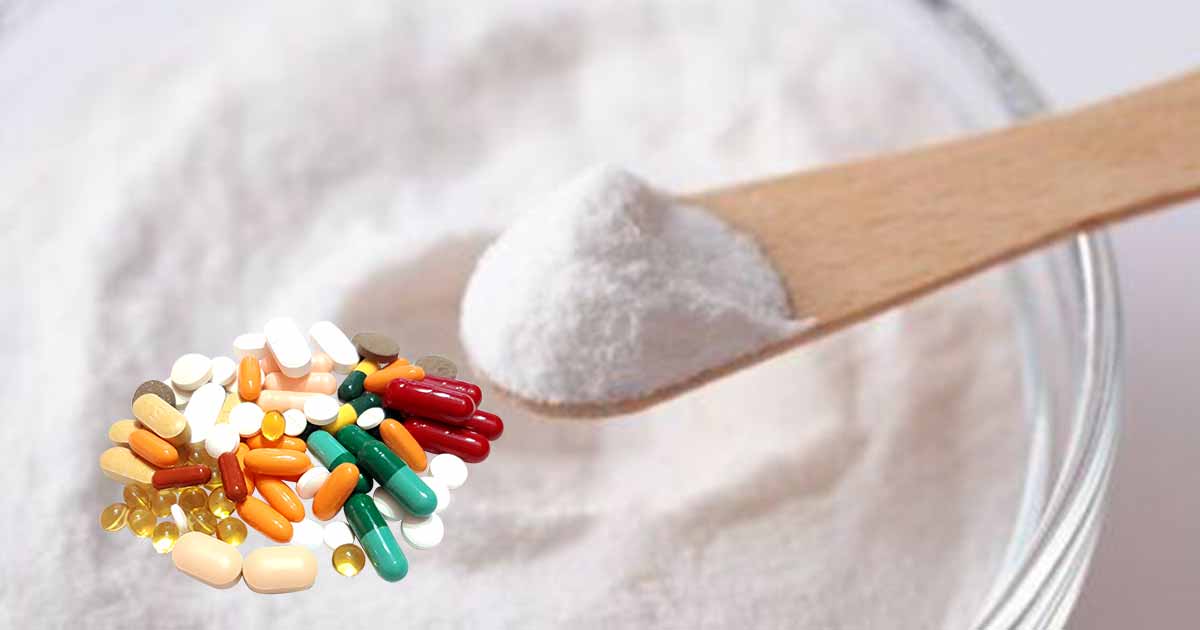A nasal cannula is a medical device used to supplement oxygen to maintain normal blood level of oxygen in patients with respiratory distress. Other patients who can benefit from the cannula are patients with sleep apnea, lung conditions, cardiac disease, and chronic obstructive pulmonary disease. The cannula has a normal oxygen flow rate of 2 to 4 L/min.
Oxygen therapy with nasal cannula is continuous except otherwise stated.
Nasal cannula need either oxygen tank or oxygen concentrator as the source of oxygen delivery source. The oxygen delivery devices may be high flow and low flow. Either nasal cannula or oxygen mask can be used for the oxygen therapy.
The nasal cannula contains plastic tubing, two hollow firm 1 cm plastic nasal prongs which seat in the nose, and are held to the face by an adjustable strap, which wraps around the patient’s ears. The flexible tube is placed under the nose and the two prongs are inserted inside the nostrils.
The device is considered a zero capacity device, as it has no built-in oxygen reservoir. The patient nasopharynx is the reservoir, hence it is best used when the patient is not mouth-breathing.
After the oxygen therapy, assessment is usually done after 72 hours. Measurements such as pulse oximetry, and arterial blood gas and/or mixed venous blood gas are done. Observable features such as skin color, alertness, respiratory rate, work of breathing, pulse rate, and blood pressure are considered.
Types of oxygen nasal cannula
There are two main types: low flow and high flow nasal cannula.
Low flow nasal cannula (LFNC):
Typically, delivers oxygen flows 4 to 6 L per minute, which equates to FiO2 of approximately 0.37 to 0.45. FiO2 delivery is directly tied to flow rate.
Low flow nasal cannula (LFNC) has a disadvantage of causing dryness and nasal mucosal irritation, and potentially, bleeding with long term use.
The system is also an open system with high likelihood of increased air leakage around the oxygen source, which may decrease efficiency.
High flow nasal cannula (HFNC):
Deliver nasal high flow therapy, where heated, humidified gases are delivered at flows of 2 to 8 L/min up to 60 L/min. It delivers high oxygen concentration than normal nasal cannula.
In this system, all settings are controlled independently, increasing the confidence and outcome. High flow nasal cannula has physiological advantages such as physiological dead space washout of waste gases including carbon dioxide (CO2), improved tidal volume, end-expiratory volume, decreased respiratory rate and positive end-expiratory pressure.
However, it has disadvantages such as the cost, complexity, decreased mobility, risk for ineffective sealing of the passageways leading to leaking of air and loss of the positive airway pressure effect, a potential to delay intubation, among others.
Nasal cannula can also be flared or straight cannula prongs.
The flow rates for adult, pediatric and neonatal cannula are mostly:
- Adults 1-6 L/min
- Neonatal/ Pediatric 0.15 L/min
Uses of Nasal cannula
The goal of using the nasal cannula is to decrease myocardial work, manage hypoxia and hypoxemia, and decrease the work of breathing in patients that needs respiratory help.
Advantages of Nasal Cannula
- It is cheaper and easy to replace
- Less bulky
- Patient can breathe through the mouth while using the cannula
- Simple, comfortable, well tolerated and less intrusive.
- Ideal for many age brackets
- Easier to remain in position while using it.
- The flow rates can be adjusted.
- Patient can eat and talk while wearing it.
Disadvantages of Nasal Cannula
- High flow rates are uncomfortable, and can dry, irritate or damage the nasopharynx.
- Oxygen level could also get higher than normal and may cause dangerous side effects.
Nasal cannula is contraindicated in:
- Patients with nasal blockage
- Patients who cannot leave the cannula in place.
- Also, patients with facial injury that may affect the use of the cannula
How to use the nasal cannula
Before the application of the cannula, you need to:
- Disposable nasal cannula and tubing.
- Humidifier (if greater than 3 L/min for Adults, always humidify for Pediatric)
- Oxygen flow meter.
Make sure you educate the patient on the reason for initiating the oxygen therapy with regard to the disease condition, on the safe ways to use the device, and ensure him or her of the safety.
Strongly advise the patient against removing the cannula except on the order of the medical personnel.
- Remove all hazard such as smoking materials
- Turn off the flow meter and plug into the outlet
- To the pre-filled humidifier, attach the humidifier cap. Also attach the connecting tube to the humidifier cap. Ensure the connections are tightly fixed.
- Leave the cannula in the wrapper
- Attach the humidifier to the flow meter and make sure you adjust the flow to the desired level.
- In situations where you are not using a humidifier, attach the cannula to the flow meter and adjust to desired flow.
- Connect the nasal cannula with the connecting tube to the humidifier. Listen carefully to ensure the flow of gas.
- If necessary, occlude the tubing to check pop-off value on the humidifier
- Place the cannula properly on the patient in the nostril. Adjust for comfort and security.
- Turn the flow meter on to the prescribed level by the doctor. Generally, each liter flow increases the inspired FiO2 by about 4%.
- Record the start of the procedure
| Liter flow | Approximate FiO2 delivered |
| 1 | 24% |
| 2 | 28% |
| 3 | 32% |
| 4 | 36% |
| 5 | 40% |
| 6 | 45% |
References
- https://www.ncbi.nlm.nih.gov/books/NBK526071/
- https://www.sciencedirect.com/topics/medicine-and-dentistry/nasal-cannula
- https://www.utmb.edu/policies_and_procedures/4230173












